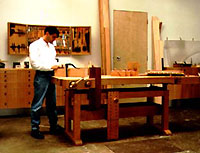 Since 1981, I have been making Italian harpsichords and clavichords in San Francisco, my native city. In recent years, I have been making small organs as well. Since 1981, I have been making Italian harpsichords and clavichords in San Francisco, my native city. In recent years, I have been making small organs as well.
Before 1981, I had been making little instruments in my apartment from old piano actions. Then, at one point, I made a harpsichord kit in a friend's garage. It turned out quite well, and although I'm good at this sort of thing, I was surprised when someone actually wanted it for themselves . . . in exchange for money, I mean! Encouraged by this turn of events, I continued by making kits for people, about ten altogether, when, in 1985, I became fascinated by the Italian harpsichord in particular. Few Italian kits were available so I soon began making Italian instruments from scratch. In comparison to the Northern-styled instruments, the lightly constructed, brass-strung Italians seemed very sexy to me and were extremely challenging to build. For example, in his book, "Three Centuries Of Harpsichord Making", Frank Hubbard compares the construction of the Northern harpsichord to the Italian one as a cuckoo clock to Brunelleschi's Duomo.
In 1987 I became intrigued with a relatively unknown but related instrument, the Italian clavichord. These tiny instruments, of which only a handful survive from the 16th century, look more like scale models of Renaissance palaces than keyboard instruments and some weigh as little as 9 pounds! I built several of these early clavichords, all of which used the same lightweight materials and construction techniques as the Italian harpsichords that I had been making already. It was not long, however, before someone asked me to build a clavichord which would be suitable for J.S. Bach and so I added to my 'line' the wonderful double-fretted instruments of C.G. Hubert, (1714-1798). These clavichords are extremely evolved in every detail and I love building them. They are also the most strictly "copied" instruments that I make, perhaps because they conform very well to my aesthetic as well as that of the copy-conscious early music market. Since 1992 I have also been producing a clavichord kit which incorporates many of the Hubert clavichord features.
About 1996, I became interested in building a small organ with wooden pipes. Pipe making is a kind of recreation for string keyboard makers. One can make a pipe in a couple of hours and then alter it easily. In this way, an intimate relationship is quickly developed with the concepts and materials involved. By comparison, harpsichord building is a much slower process, yeilding a less alterable product.
The little organ which I built employs a system of hand-raised wind which was, for me, the most challenging aspect of the project. However impractical, the experience of organ playing now seems senseless to me without it. But I am the impractical instrument maker. My aesthetic seems to be "make it small, make it light, let it be elemental in every way, and, for goodness sake, don't paint it!" Currently I am finishing a larger organ, seven stops (8' ged., 4' chimney, 4' quintdena, 2 2/3', 2', 1 3/5', and 1'), all wood pipes and, of course, hand-raised wind.
Please visit my instrument site, constructed for your perusal by Joe Kuo. Photos by Geoff Wong and Paul Shulz.
|